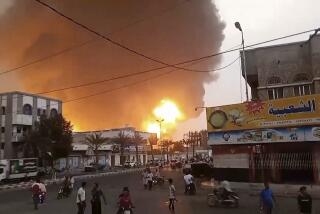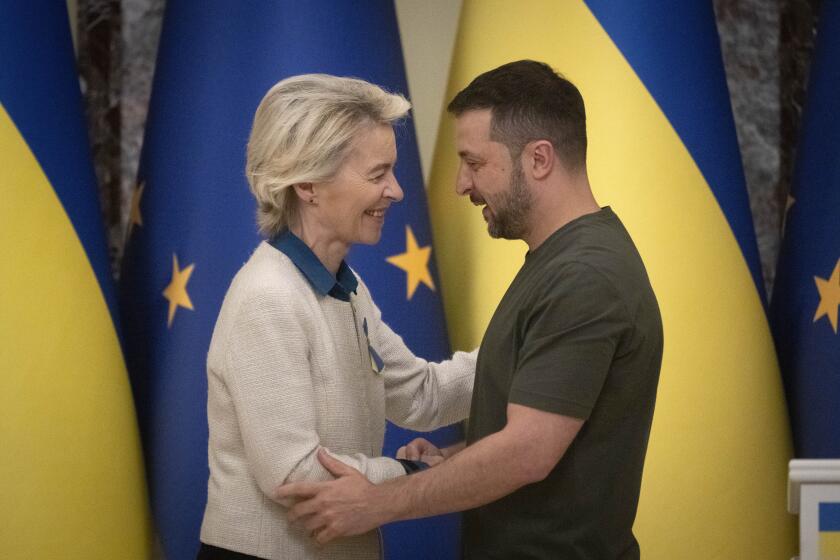Iranian diplomat kidnapped in Yemen is freed
An Iranian diplomat kidnapped and held in Yemen for almost 20 months has been freed and arrived Thursday in Tehran, officials said.
Iranian authorities credited an “intelligence operation” for the liberation of the diplomat, Nour Ahmad Nikbakh, but declined to provide specifics.
The freed diplomat was pictured on Iranian television being greeted by tearful relatives as he arrived Thursday morning at Tehran’s Mehrabad Airport. Nikbakh told reporters he was kidnapped by “armed terrorists” on July 21, 2013, on his way from his home in Sana to the Iranian Embassy.
Iran’s deputy prime minister, Hossein Amir-Abdollahian, appeared with the released diplomat at a news conference and told reporters that the release came about “after a series of complex and arduous operations inside a restive region of Yemen,” reported Press TV, Iran’s official English-language news service. Iranian authorities lauded the effort as in an intelligence coup for the Islamic Republic.
His release comes after members of Yemen’s Houthi minority, which is closely allied with Iran, consolidated power in Sana in February in a move condemned as illegal by the United Nations and by Washington and its allies. Whether the Houthi rise to power had anything to do with the Iranian diplomat’s release was not clear.
The United States and its Persian Gulf and European allies pulled their diplomatic personnel from Sana after the Houthi takeover and advised citizens to leave the country amid a dangerous power vacuum. But Iran has maintained its diplomatic presence in Sana, and Iranian media have boasted of Tehran’s growing influence in Arab capitals, from Sana to Beirut, Damascus to Baghdad.
In December, a car bomb targeted the residence of the Iranian ambassador in Sana, killing one Yemeni civilian and two soldiers and wounding more than a dozen bystanders, according to news accounts. No Iranian diplomats were injured in that attack, Tehran said. That assault was reportedly tied to Al Qaeda in the Arabian Peninsula, the Al Qaeda affiliate in Yemen, which is viewed as among the global terror network’s most active branches. Al Qaeda, a Sunni Muslim group, views Shiite Iran as a mortal enemy.
Various armed factions in Yemen, including Al Qaeda, which has close ties to Yemeni tribes, have been implicated in multiple abductions of foreign nationals, including U.S. citizens. Kidnapping of foreigners is a major money-generator for various Yemeni armed factions, according to security experts and diplomats. Negotiators have worked with tribal intermediaries in efforts to free abducted foreigners. A number of European and other captives have been released in recent years, reportedly after payments of ransoms. But some hostages have been killed.
In December, U.S. authorities say, a pair of hostages -- Luke Somers, an American journalist, and Pierre Korkie, a South African teacher -- were shot dead by their Al Qaeda captors during a failed rescue attempt by U.S. commandos in southern Yemen.
Earlier this month, a Saudi diplomat, Abdullah Khalidi, Riyadh’s deputy consul in the southern port city of Aden, was released after almost three years in captivity. The Saudi diplomat was held by Al Qaeda, which demanded $20 million for his release, according to Yemeni media reports. Saudi officials said he was freed after “intensive efforts” by the kingdom’s security services, but provided no details.
Last month, a French aid worker, Isabelle Prime, 30, who was working on a World Bank-funded development project, was kidnapped along with a Yemeni colleague by unknown assailants in broad daylight as they rode in a taxi in Sana, according to diplomats and security personnel. Negotiations are reportedly continuing to win her release.
Mostaghim is a special correspondent. Staff writer McDonnell contributed to this reports from Beirut.
Twitter: @mcdneville
More to Read
Sign up for Essential California
The most important California stories and recommendations in your inbox every morning.
You may occasionally receive promotional content from the Los Angeles Times.










